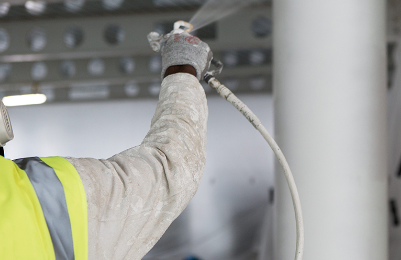Intumescent paints are categorised as "reactive paints", as when they come into contact with the heat from a fire, they will react to serve as passive fire protection. Ark Fire Protection, a passive fire protection company, states that "Intumescent coatings react with the heat caused from a fire, specifically temperatures exceeding 120°C. When exposed to temperatures above this threshold, the paint will intumesce up to 50 times the thickness of the original paint forming a proactive, carbon layer which thermally insulates the material for a set period of time". During this period, people may be safely evacuated from the structure and the building's structural integrity is preserved before firefighters can douse the fire.
How Exactly Do Intumescent Paints Work?
Endothermic reactions enable intumescent paints to protect surfaces. They absorb heat from the surrounding environment and undergo a chemical change that causes them to rapidly expand (the Latin word "tumesco," from which intumescent is derived, means "to swell"). A thin-film coating of intumescent paint will typically expand at a rate of 50:1, whereas a thick-film coating will generally expand at a rate of 5:1. This expansion results in a microporous carbonaceous foam that effectively reduces the rate of heat transfer between the fire and the underlying surface.
Why Do We Need Intumescent Paint?
In a fire, it is critical that the building's structural frame be correctly safeguarded to prevent the materials from reaching their critical failure temperature, potentially causing the structure to collapse. Intumescent paint not only prevents this from happening but also allows occupants to exit safely by slowing the spread of fire; potentially saving lives.
Which Materials Does Intumescent Paint Protect?
Intumescent paint may be used to coat a number of things, including steel, wood, concrete, and composite materials. Here are some examples of how it is used with these materials:
Intumescent Paint for Steel
Steel has a critical temperature of between 350°C to 750°C. Its nominal tensile strength and load-bearing capacity begin to rapidly deteriorate as the temperature rises, posing an increased danger of structural failure. To extend the time it takes to reach the critical temperature, intumescent paint may be used on a number of steel components, including beams, columns, brackets, and studs.
Spraying is the most efficient method for applying intumescent paint to steel structures. It can be used straight on the surface of steel or over a compatible anti-corrosion primer. It's also possible to add a top layer of paint for aesthetic reasons, but it must pass testing with the intumescent coating.
Intumescent Paint for Timber
Timber structural components, such as beams, char at a rate of 0.8mm/min and emit combustible gases, which contribute to the fire's spread. Despite its inherent natural fire-resistant qualities, timber can be made fireproof by applying a thin-film intumescent coating.
Intumescent paint can be brushed onto the surface of timber structures or sprayed on. Clear intumescent paint is available in various colors and can be used to preserve the look of wood.
Intumescent Paint for Concrete
Concrete is highly resistant to fire damage as a non-combustible, non-toxic substance with low thermal conductivity. Although its exact fire resistance is determined by factors such as density, moisture content, and thickness, it can usually withstand temperatures in excess of 900°C without suffering significant loss of load-bearing capacity.
Concrete surfaces can be treated with Intumescent paint using a brush, roller, or spray. It's fairly typical to use intumescent paint on concrete ceilings and walls to prevent and control fire damage. When utilised in conjunction with other compartmentation methods (like firestopping sealants), it can significantly enhance passive fireproofing for concrete buildings.
Intumescent paint, whether used in residential or commercial structures, improves the structure's passive fireproofing. It helps to keep the integrity of a building and allows residents more time to exit by slowing down the heat flow from fires to internal components.
* This is a contributed article and this content does not necessarily represent the views of sciencetimes.com















